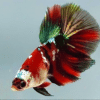-
×

-
×
 6 x Golden Dwarf Barb: A Jewel for the Aquarium Scientific Name: Pethia gelius (formerly Puntius gelius), Easy Care Freshwater Fish for Vibrant Aquarium Setups, Perfect for Community Tanks
2 × £21.29
6 x Golden Dwarf Barb: A Jewel for the Aquarium Scientific Name: Pethia gelius (formerly Puntius gelius), Easy Care Freshwater Fish for Vibrant Aquarium Setups, Perfect for Community Tanks
2 × £21.29 -
×

-
×

-
×

Subtotal: £226.44












Emily Carter (verified owner) –
I recently purchased the Stunning Halfmoon Nemo Betta Breeding Pair, and I couldn’t be happier! Upon arrival, both fish were vibrant and healthy, which is so important for any fish lover. The male’s fins are just breathtaking, showcasing those iconic colors that truly light up my aquarium. I’ve had them for about two months now, and they are thriving! They interact beautifully, with the male displaying all sorts of charming behaviors while courting the female.
Compared to other Betta splendens I’ve owned, this pair has been the most lively and engaging. Their compatibility has been fantastic, and I’ve seen no signs of stress or aggression—key factors for a happy tank. I also appreciate the care taken during shipping; they arrived safely packed with easy-to-follow acclimation instructions.
If you’re a fellow Betta enthusiast or just starting your aquarium journey, I highly recommend this pair. They not only enhance your tank’s beauty but also bring a delightful energy that makes fishkeeping so rewarding. Just be sure to provide them with a suitable environment and watch for their playful antics! You’ll adore them just like I do.